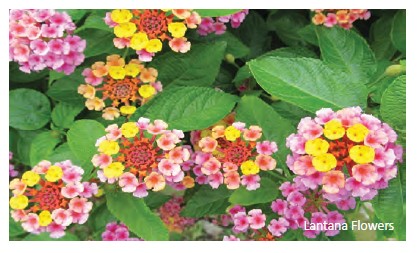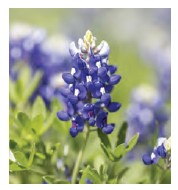They appear in abundance across Galveston Island from the east end to the far west end—along roadways, in abandoned yards, city lots, cemeteries, pastures, and even residential gardens. Over five thousand species of wild, flowering plants exist in the state of Texas, a statistic made even more incredible by the fact that in order to be considered a common wildflower, it must occur over a large area, have a long bloom period, or be widespread in a particular region.
One of the most broadly recognized species of Texas wildflowers is the Indian Paintbrush, an upright annual or perennial herb native to Texas, although its red-orange flower color is an optical illusion. The flower is actually a tiny creamy whitish-yellow bloom encircled by red-orange leaf-like bracts.
Other widespread varieties include the Primrose Buttercup, a cup-shaped bloom with rose to pale pink flowers and a yellow or white center, and the Oxeye Daisy, a typical meadow plant that thrives in a variety of locations such as dry fields and roadside ditches. The game, "He loves me, he loves me not," is associated with this flower.
The Coneflower is an annual herb with elongated leaves that clasp around the stem at the base. The flower heads are similar in shape to the black-eyed Susan but are smaller and come in a large variety of colors. Lastly, the Cosmos is a fast-growing plant with brightly-colored single or double flowers in white, pink, orange, yellow, or scarlet.
These beautiful blooms will undoubtedly spring up in great quantities, both locally and across Texas, but watch for and take delight in the profusion of other wildflower blossoms. Among them are the thousands of beautiful Brown-eyed Susans (Rudbeckia), a prairie species found throughout Texas.
This is a stiffly upright to sprawling perennial, growing 1-3 feet with blooms that will last several days when used as a cut flower. It is said that the Indians used juice from the roots of Rudbeckia in the treatment of earaches.
Here on the Island, common sunflowers (Asteraceae) will be seen in the fields and pastures of the West End and then again in front yards of the East End. Sometimes reaching a height of ten feet, the common sunflower grows on a stout, upright stalk ending with a huge yellow disk of a bloom. The sunflower is also a practical plant, formerly used by Native Americans for medicines, as a source of fiber, and as a highly nutritious food.

 Another member of the sunflower family prevalent in Texas is the Indian Blanket (Gaillardia pulchella), and it will soon show itself by the thousands. It is called “fire wheel” from its appearance of an orange wheel with yellow rays at the tips. The common Dandelion, although viewed by some as a weed and a nuisance, is in fact a colorful wildflower and also a member of the sunflower family.
Another member of the sunflower family prevalent in Texas is the Indian Blanket (Gaillardia pulchella), and it will soon show itself by the thousands. It is called “fire wheel” from its appearance of an orange wheel with yellow rays at the tips. The common Dandelion, although viewed by some as a weed and a nuisance, is in fact a colorful wildflower and also a member of the sunflower family.
Blooming nearly year-round in yards everywhere, the fruit of the dandelion is as familiar as the flowers. Numerous seeds with stalked, white feathery bristles at the tip are congested in a round fluffy ball and readily fly away on the wind or the slightest breath when fully mature. Dandelion greens have been used as a vegetable for years, and it is said that the flowers will produce a “delightful golden wine.”
Appearing perennially, the wild Lantana across the Island is a pleasure in itself. Wild lantanas are plants of the genus Abronia, sometimes called "sand-verbenas," that have naturalized along the Gulf Coast.
Blooming spring through summer and fall, the lantana is a favorite hangout for butterflies. Lantana's aromatic clusters are a mix of red, orange, and yellow, typically changing color as they mature. A favorite among these is the Lantana Camara, more commonly known as "Ham 'n Eggs" due to its pink and yellow inflorescences.
Last but certainly not least, a favorite Texas springtime tradition is posing for a family portrait among fields blanketed by the official state flower—the bluebonnet. Growing profusely all over Texas, the bluebonnets have been as much a part of Texas lore as cowboys and Longhorn cattle, but lesser known is the fact that this flourishing flower actually presents itself in five different varieties.
As spring quickly approaches, take time to enjoy the gradual “greening-up” and the re-appearance of color, and then prepare to be dazzled by Mother Nature’s fancy spring show in the coming months.
 Bluebonnet Varieties
Bluebonnet Varieties
Annual Lupine (Lupinus concinnus)- the tiniest bluebonnet, a mere 2-5 inches tall in color combinations of lavender, white, and rosy purple. Annual Lupine bluebonnets will flower in early spring in the “Trans-Pecos” region of the far western Panhandle.
Big Bend or Chisos Bluebonnet (Lupinus havardii)- the tallest variety with a more vigorous growth than other bluebonnets, and the blossoms have a darker hue. Blooming from January to June, the Chisos Bluebonnet can be found growing in deserts, valleys, and on mountain slopes.
Dune Bluebonnet (Lupinus plattensis)- a dark blue or purplish flower with a bright white spot at the base. It blooms in April and May and prefers the sandy soil and dunes of the Panhandle region.
Sandyland Bluebonnet (Lupinus subcarnosus)- has an erect rambling blossom that is bright blue with a white center that turns purplish after it has been pollinated. A bluebonnet that prefers the sandy soils, it can be found blooming on rangeland and on the edges of woodlands in March and April. The Sandyland Bluebonnet was adopted as the State Flower in 1901, but as it is less “showy” than other species, the legislature decided to make all bluebonnets the State Flower.
Texas Bluebonnet (Lupinus texensis)- boasts numerous blossoms in dense spikes and an “intoxicating” scent. Flourishing in sandy soils or sandy clay, Texas Bluebonnets grow in the plains, brush-lands, flats, and pastures as well as along hillsides and slopes. This is the bluebonnet that has been widely planted by the highway department in a roadside beautification and erosion control program which was initiated by “Ladybird” Johnson. Texas Bluebonnets bloom profusely from March to May.